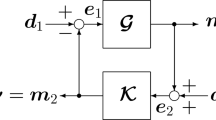Abstract
The control problem for linearised three-dimensional perturbations about a nominal laminar boundary layer over a flat plate (the Blasius profile) is considered. With a view to preventing the laminar to turbulent transition, appropriate inputs, outputs, and feedback controllers are synthesised that can be used to stabilise the system. The linearised Navier–Stokes equations are reduced to the Orr–Sommerfeld and Squire equations with wall-normal velocity actuation entering through the boundary conditions on the wall. An analysis of the work-energy balance is used to identify an appropriate sensor output that leads to a passive system for certain values of the streamwise and spanwise wavenumbers. Even when the system is unstable, it is demonstrated that strictly positive real feedback can stabilise this system using the special output.






Similar content being viewed by others
References
Bagheri S, Brandt L, Henningson DS (2009) Input-output analysis, model reduction, and control of the flat-plate boundary layer. J Fluid Mech 620:263–298
Belson BA, Semeraro O, Rowley CW, Henningson DS (2013) Feedback control of instabilities in the two-dimensional blasius boundary layer: the role of sensors and actuators. Phys Fluids 25:054106
Benhabib RJ, Iwens RP, Jackson RL (1981) Stability of large space structure control systems using positivity concepts. J Guidance Control 4:487–494
Bewley TR (2001) Flow control: new challenges for a new renaissance. Prog Aerosp Sci 37:21–58
Bewley TR, Liu S (1998) Optimal and robust control and estimation of linear paths to transition. J Fluid Mech 365:305–349
Bridgeman LJ, Forbes JR (2014) Conic-sector-based control to circumvent passivity violations. Int J Control 87(8):1467–1477
Butler KM, Farrell BF (1992) Three-dimensional optimal perturbations in viscous shear flow. Phys Fluids A: Fluid Dyn 4(8):1637–1650
Damaren CJ (2016) Laminar-turbulent transition control using passivity analysis of the Orr–Sommerfeld equation. J Guidance Control Dyn 39(7):1602–1613
Desoer CA, Vidyasagar M (1975) Feedback systems: input-output properties. Academic Press, Cambridge
Drazin PG, Reid WH (1981) Hydrodynamic stability. Cambridge University Press, Cambridge
Heins PH, Jones BL, Sharma AS (2016) Passivity-based output-feedback control of turbulent channel flow. Automatica 69:348–355
Joshi SS, Speyer JL, Kim J (1997) A systems theory approach to the feedback stabilization of infinitesimal and finite-amplitude disturbances in plane poiseuille flow. J Fluid Mech 332:157–184
Kim J, Bewley TR (2007) A linear systems approach to flow control. Ann Rev Fluid Mech 39:383–417
Mamou M, Khalid M (2004) Finite element solution of the Orr–Sommerfeld equation using high precision hermite elements: plane poiseuille flow. Int J Numer Methods Fluids 44:721–735
Safonov MG, Jonckheere EA, Verma M, Limebeer DJN (1987) Synthesis of positive real multivariable feedback systems. Int J Control 45(3):817–842
Schlichting H (1979) Boundary-layer theory, 7th edn. McGraw-Hill, New York
Schmid PJ (2001) Stability and transition in shear flows. Springer, New York
Sharma AS, Morrison JF, McKeon BJ, Limebeer DJN, Koberg WH, Kerwin SJ (2011) Relaminarisation of ReT = 100 globally stabilising linear feedback control. Phys Fluids 23:125105
Vidyasagar M (1992) Nonlinear control systems, 2nd edn. Prentice-Hall Inc, Upper Saddle River
Zames G (1966) On the input-output stability of time-varying nonlinear feedback systems. Part I: conditions derived using concepts of loop gain, conicity, and positivity. IEEE Trans Autom Control 11(2):228–238
Author information
Authors and Affiliations
Corresponding author
Ethics declarations
Conflict of interest
The author declares that he has no conflict of interest.
Additional information
Professor and Director, University of Toronto Institute for Aerospace Studies, 4925 Dufferin Street. Associate Fellow AIAA.
Rights and permissions
About this article
Cite this article
Damaren, C.J. Transition control of the Blasius boundary layer using passivity. AS 2, 21–31 (2019). https://doi.org/10.1007/s42401-018-0021-0
Received:
Revised:
Accepted:
Published:
Issue Date:
DOI: https://doi.org/10.1007/s42401-018-0021-0




